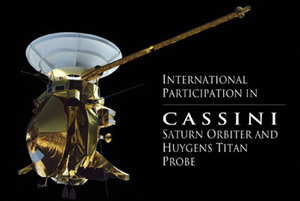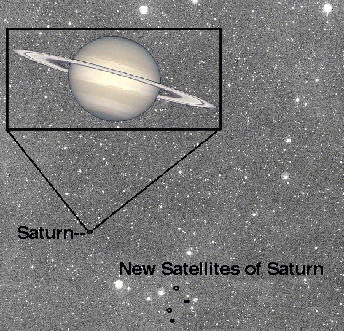This shows the relative position of the new satellites with respect to where Saturn resides. These moons are the outmost moons of Saturn.
Click on image for full size
Adapted from Image from Observatoire de la Cote d'Azur
Saturn Holds Title for Most Moons!
News story originally written on November 9, 2000
In the last 20 years, there have been many observations that lead us to think that
Saturn has many more small moons than we previously thought. In fact, October 26, 2000, a group of astronomers announced their discovery of 4 new
moons of Saturn. Good observations back the claim to these being true satellites. For now, their names are S/2000 S1, S/2000 S2, S/2000 S3 and S/2000 S4. They will be renamed once they are confirmed.
These new moons are very small moons (less than 50 km across) and are likely icy moons. They are the outermost of all of Saturn's moons.
Many other moons thought to be in orbit around Saturn have been reported during the last two decades. In some cases, there are not good observations of these moons and some think they were merely clumps of material and not really true satellites. It will be up to the Cassini probe's arrival in 2004 to confirm all of these moon sightings, including a verification of S/2000 S1-S4.
As of last week, Saturn's moon count was 18. Now that total rises to 22, but that total could certainly rise farther and farther as Cassini gets closer to the Saturnian system.
You might also be interested in:

The Cassini probe began its journey to Saturn on October 15, 1997. It flew by Earth in August, 1999, before heading towards the distant planet. Cassini passed Jupiter in 2000 and then burned towards its
...more
It was another exciting and frustrating year for the space science program. It seemed that every step forward led to one backwards. Either way, NASA led the way to a great century of discovery. Unfortunately,
...more
The Space Shuttle Discovery lifted off from Kennedy Space Center at 2:19 p.m. EST, October 29th. The sky was clear and the weather was great as Discovery took 8 1/2 minutes to reach orbit for the Unitied
...more
A moon was discovered orbiting the asteroid, Eugenia. This is only the second time in history that a satellite has been seen circling an asteroid. A special mirror allowed scientists to find the moon
...more
Will Russia ever put the service module for the International Space Station in space? NASA officials are demanding an answer from the Russian government. The necessary service module is currently waiting
...more
During a period of about two days in early May, 1998, the ACE spacecraft was immersed in plasma associated with a coronal mass ejection (CME). The SWICS instrument on ACE, which determines unambiguously
...more
J.S. Maini of the Canadian Forest Service has referred to forests as the "heart and lungs of the world." Forests reduce soil erosion, maintain water quality, contribute to atmospheric humidity and cloud
...more















